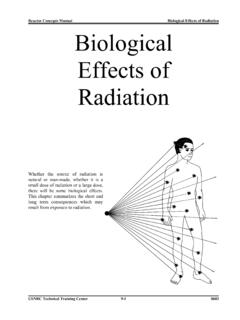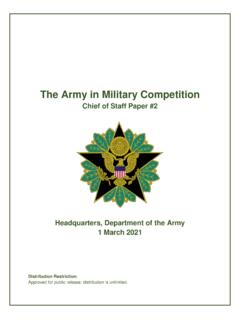Transcription of Introduction to Mediation, Moderation, and Conditional ...
1 2013, HardcoverISBN 978-1-60918-230-47" x 10", 494 Pages, $ PRICE: $ to Mediation, Moderation, and ConditionalProcess AnalysisA Regression-Based ApproachAndrew F. Hayes This decidedly readable, informative book is perfectly suited for a range of audiences, from thenovice graduate student not quite ready for SEM to the advanced statistics instructor. Even theseasoned quantitative methodologist will benefit from Hayes's years of accumulated wisdom as heexpertly navigates this burgeoning and at times inconsistent literature. This book is particularlywell suited for graduate-level courses. Hayes brings Conditional process analysis to life with suchpassion that even the most 'stat-o-phobic' will become convinced that they too can master SPSS (orSAS) process.
2 The thoughtful use of real-life examples, accompanied by SPSS and SAS syntax andoutput, makes the book highly accessible. Shelley Brown, PhD, Department of Psychology, Carleton University, Canada A welcome contribution. This book's accessible language and diverse set of examples will appealto a wide variety of substantive researchers looking to explore how or why, and under whatconditions, relationships among variables exist. Hayes has a unique ability to effectivelycommunicate technical material to nontechnical audiences. He facilitates application of severalcutting-edge statistical models by providing practical, well-oiled machinery for conducting theanalyses in practice. I can use this book to enhance my graduate-level mediation class by extendingthe course to include more coverage on differentiating mediation versus moderation and onconditional process models that simultaneously evaluate both effects together.
3 Amanda Jane Fairchild, PhD, Department of Psychology, University of South Carolina Mediation and moderation are two of the most widely used statistical tools in the social and experienced researchers have been waiting for a clear, engaging, and comprehensivebook on these topics for years, but the wait has been worth it this book is an absolute his usual clarity, Hayes has written what will become the default resource on mediation andmoderation for many years to come. Andy Field, PhD, School of Psychology, University of Sussex, United Kingdom Hayes provides an accessible, thorough Introduction to the analysis of models containingmediators, moderators, or both. The text is easy to follow and written at a level appropriate for anintroductory graduate course on mediation and moderation analysis.
4 The book is also an extremelyuseful resource for applied researchers interested in analyzing Conditional process models. Onestrength is the inclusion of numerous examples using real data, with step-by-step instructions foranalysis of the data and interpretation of the results. This book's largest contribution to the field isits replacement of the confusing terminology of mediated moderation and moderated mediationwith the clearer and broader term Conditional process model. Matthew Fritz, PhD, Department of Psychology, Virginia Polytechnic Institute and StateUniversityThis engaging book explains the fundamentals of mediation and moderation analysis and theirintegration as Conditional process analysis.
5 Procedures are described for testing hypotheses aboutthe mechanisms by which causal effects operate, the conditions under which they occur, and themoderation of mechanisms. Relying on the principles of ordinary least squares regression, AndrewHayes carefully explains the estimation and interpretation of direct and indirect effects, probing andvisualization of interactions, and testing of questions about moderated mediation. Examples usingdata from published studies illustrate how to conduct and report the analyses described in the special value, the book introduces and documents PROCESS, a macro for SPSS and SAS thatdoes all the computations described in the book. The author's website ( ) offers freedownloads of PROCESS plus data files for the book's full information about this title Publications, Spring Street, New York, NY 10012 Order Toll-Free:9 AM - 5 PM Eastern800-365-7006 (or 212-431-9800)Fax:212-966-6708 (24 hrs)Professor to Mediation, Moderation, and Conditional Process AnalysisCopies in HardcoverISBN 978-1-60918-230-4, $ , $ ** Many Guilford titles are available as e-books directly from our website or from major e-book vendors, including Amazon, Barnes & Noble, and Google Play.
6 If an e-book is available, youcan find it for sale on Guilford's product page along with the print edition(s). For titles that are coming soon, the e-book format will be published shortly after the print edition(s).Go for more Templates for PROCESS for SPSS and SASc 2013 Andrew F. Hayes, 1 Conceptual DiagramStatistical DiagramConditional effect of X on Y = b1 + b3 MModel Templates for PROCESS for SPSS and SASc 2013 Andrew F. Hayes, 2 Conceptual DiagramStatistical DiagramConditional effect of X on Y = b1 + b4M + b5 WWXWXMb4b5 Model Templates for PROCESS for SPSS and SASc 2013 Andrew F. Hayes, 3 Conceptual DiagramStatistical DiagramConditional effect of X on Y = b1 + b4M + b5W+ b7 MWXWXMb4b5 XMWMWb6b7 WModel Templates for PROCESS for SPSS and SASc 2013 Andrew F.
7 Hayes, 'Model 4 Conceptual DiagramStatistical DiagramIndirect effect of X on Y through Mi = ai biaibiMiYXeMi1 direct effect of X on Y = c'*Model 4 allows up to 10 mediators operating in parallelModel Templates for PROCESS for SPSS and SASc 2013 Andrew F. Hayes, 5 Conceptual DiagramStatistical DiagramIndirect effect of X on Y through Mi = ai biaibiMiYXeMi1 Conditional direct effect of X on Y = c1' + c3'W*Model 5 allows up to 10 mediators operating in parallelWWXWc1'c2'c3'Model Templates for PROCESS for SPSS and SASc 2013 Andrew F. Hayes, Model 6 (2 mediators)Conceptual DiagramStatistical DiagramIndirect effect of X on Y through Mi only = ai bieM11 direct effect of X on Y = c'M2M1 YXc'a1M2a2b1b2d21eM21 indirect effect of X on Y through M1 and M2 in serial = a1 d21 b2 Model Templates for PROCESS for SPSS and SASc 2013 Andrew F.
8 Hayes, DiagramStatistical Diagram Model 6 (3 mediators)YXM1M3M2 YXM1M3M2eM3eYeM1eM2c ' b1 b2 b3 a1 a2 a3 d21 d32 d31 1111 indirect effect of X on Y through Mi only = ai biDirect effect of X on Y = c' indirect effect of X on Y through M1 and M2 in serial = a1 d21 b2 indirect effect of X on Y through M1 and M3 in serial = a1 d31 b3 indirect effect of X on Y through M1, M2, and M3 in serial = a1 d21 d32 b3 indirect effect of X on Y through M2 and M3 in serial = a2 d32 b3 Model Templates for PROCESS for SPSS and SASc 2013 Andrew F. Hayes, DiagramStatistical Diagram Model 6 (4 mediators)YXM1M3M2a1 indirect effect of X on Y through Mi only = ai biDirect effect of X on Y = c' indirect effect of X on Y through M1 and M2 in serial = a1 d21 b2 indirect effect of X on Y through M1 and M3 in serial = a1 d31 b3 indirect effect of X on Y through M1, M2, M3, and M4 in serial = a1 d21 d32 d43 b4 indirect effect of X on Y through M2 and M3 in serial = a2 d32 b3M4eM11 YXM1M3M2M4eM21eM31eM41eY1a2 a3 a4 c ' b3 b4 b2 b1 d32 d21 d43 d31 d42 d41 indirect effect of X on Y through M1 and M4 in serial = a1 d41 b4 indirect effect of X on Y through M2 and M4 in serial = a2 d42 b4 indirect effect of X on Y through M3 and M4 in serial = a3 d43 b4 indirect effect of X on Y through M1, M2.
9 And M3 in serial = a1 d21 d32 b3 indirect effect of X on Y through M1, M2, and M4 in serial = a1 d21 d42 b4 indirect effect of X on Y through M1, M3, and M4 in serial = a1 d31 d43 b4 indirect effect of X on Y through M2, M3, and M4 in serial = a2 d32 d43 b4 Model Templates for PROCESS for SPSS and SASc 2013 Andrew F. Hayes, 'Model 7 Conceptual DiagramStatistical DiagramConditional indirect effect of X on Y through Mi = (a1i + a3iW)bia1ibiMiYXeMi1 direct effect of X on Y = c'*Model 7 allows up to 10 mediators operating in parallelWWXWa2ia3iModel Templates for PROCESS for SPSS and SASc 2013 Andrew F. Hayes, 8 Conceptual DiagramStatistical DiagramConditional indirect effect of X on Y through Mi = (a1i + a3iW)bia1ibiMiYXeMi1 Conditional direct effect of X on Y = c1' + c3'W*Model 8 allows up to 10 mediators operating in parallelWWXWa2ia3ic1'c2'c3'Model Templates for PROCESS for SPSS and SASc 2013 Andrew F.
10 Hayes, 'Model 9 Conceptual DiagramStatistical DiagramConditional indirect effect of X on Y through Mi = (a1i + a4iW + a5iZ) bia1ibiMiYXeMi1 direct effect of X on Y = c'*Model 9 allows up to 10 mediators operating in parallelWWZa2ia3iZXWXZa4ia5iModel Templates for PROCESS for SPSS and SASc 2013 Andrew F. Hayes, 10 Conceptual DiagramStatistical DiagramConditional indirect effect of X on Y through Mi = (a1i + a4iW + a5iZ) bia1ibiMiYXeMi1*Model 10 allows up to 10 mediators operating in parallelWWZa2ia3iZXWXZa4ia5ic1'c2'c3'c4' c5' Conditional direct effect of X on Y = c1' + c4'W + c5'ZModel Templates for PROCESS for SPSS and SASc 2013 Andrew F. Hayes, 11 Conceptual DiagramStatistical DiagramXWWZXZXWZZZeMiMic'a1ia2ia3ia4ia5i bia6ia7iConditional indirect effect of X on Y through Mi = (a1i + a4iW + a5iZ + a7iWZ) bi*Model 11 allows up to 10 mediators operating in parallelDirect effect of X on Y = c'WMi1 Model Templates for PROCESS for SPSS and SASc 2013 Andrew F.







